
Service Learning
Energize your Course with Service Learning!
Service-learning is “a course-based, credit-bearing educational experience in which students
- participate in an organized service activity that meets identified community needs and
- reflect on the service activity in such a way as to gain further understanding of course content, a broader appreciation of the discipline, and an enhanced sense of civic responsibility.” Bringle, R.G. & Hatcher J.A. A Service-Learning Curriculum for Faculty. Michigan Journal of Service Learning. Fall 1995, pp 112-122.
Faculty report that adding a service-learning component to their course increases student interest in, appreciation of, and engagement with their courses. Courses from all colleges incorporate service-learning.
- College of Arts & Sciences
-
Course Rubric Course Name Instructor ART 220 Graphic Design I David Mazure ART 405 Illustration David Mazure & Rebecca Kilicaslan ART 420 Graphic Design III: Design Agency David Mazure MATH 150 Mathematical Investigations Various MATH 425 Introduction to Mathematical Modeling Olivia Carducci PSY 105 Infant and Early Childhood Development Bonnie Green PSY 306 Cross Cultural Counseling Anthony Drago PSY 341 Measurement and Evaluation Bonnie Green SOSW 373 Social Work with Communities and Organizations Laurene Clossey SOC 378 American Community Annika Wilcox - College of Business
-
Course Rubric Course Name Instructor HRTM 201 Foundations of Event Planning Management Stanley Chiang HRTM 211 Principles of Food and Beverage Management Chuck Meitner HRTM 436 Meeting and Convention Planning and management Daisy Wang MGT 204 Principles of Marketing Daisy Wang MGT 315 Entrepreneurial Finance Daisy Wang MGT 335 Tax Accounting Robert Thomas MGT 353 Small Business Management Carol Dimopoulos MGT 362 Globalization and International Management Daisy Wang MGT 375 Innovation and New Product Development Carol Dimopoulos RECR 350 Special Event and Program Planning Stanley Chiang SMGT 445 Organization and Administration of Sport Operations Edward Arner SMGT 409 Concept of Sprt Marketing Jaedeock Lee - College of Education
-
Course Rubric Course Name Instructor ECED 232 Child Development and Cognition Nurun Begum ECED 420 Advocacy, Leadership and Collaboration Courtney Lepore PSED 250 The Psychology of Learners in Diverse Communities Karl Mundi PSED 244 Adolescent Psychology Ronald (Jay) Starnes SPED 313 Curriculum and Instruction for Students with Low Incidence Disabilities Michelle LaBadie SPED 314 Curriculum and Instruction for Students with High Incidence Disabilities Domenico Cavaiuolo SPED 351 Collaboration for Inclusion Gina Scala - College of Health Sciences
-
Course Rubric Course Name Instructor EXP 532 Clinical Exercise Physiology Lab II C Tiffany Jordan, Chad Witmer, Shala Davis HLSC 715 Administration and Management of Health Sciences Shala Davis SPPA 121 Introduction to Communication Disorders Katherine Lazzara SPPA 321 Communication and Aging Various Faculty SPPA 457 Introduction to Clinical Practice Katherine Lazzara SPPA 534 Clinical Audiology Susan Dillmuth-Miller SPPA 535 Auditory Based Communication Disorders Susan Dillmuth-Miller SPPA 550 Advanced Clinical Practicum Aklia Rajappa, Katherine Lazzara, Rachel Wolf, LuAnn Batson-Magnuson SPPA 560 Diagnostic Method Rachel Wolf
Service-learning is one of eleven high-impact practices recognized by the American Association of Colleges and Universities (AAC&U). AAC&C chose their high impact practices “based on evidence of significant educational benefits for students who participate in them—including and especially those from demographic groups historically underserved by higher education.”
The Service-Learning Initiative Committee is a university-wide group of faculty who seek to expand opportunities to apply classroom knowledge in meeting the social needs of the community in a broader quest for the common good. Service Learning, whether through short or long-term community service projects, affords students the opportunity to integrate theory into practice, apply practical skills, clarify values, and raise consciousness about community issues.
- Service Learning Articles/Book Chapters by ESU Faculty
-
- Batson-Magnuson, B. Sockman, L. Clossey, and O. Carducci Designing for Service-Learning Experiences (2022) In Stefaniak, J and Reese, R (eds) The Instructional Design Trainer’s Guide: Authentic Practices and Considerations for Mentoring ID and Ed Tech Professionals, Routledge
- Scott, E. M. (2020). Redefining the pedagogy: Service-learning in libraries and archives. Pennsylvania Libraries: Research and Practice, 8 (1), 37-48.
- Sockman, L. Clossey, O. Carducci, L. Magnuson, D. Mazure, G. White, A. Wehmeyer, B. Green, H. Wells, Systems Thinking as a Heuristic for the Implementation of Service Learning in Higher Education (2019) In Spector M., Lockee B., Childress M. (eds) Learning, Design, and Technology, Springer.
- Batson-Magnuson, O. Carducci, L. Clossey. Service-Learning. In M. Ball and P Pruim Eds. First Year Experience Reader. San Francisco: Cognella Press (2018).
- Sockman, B. R., Carducci, O. M., Clossey, L., Batson-Magnuson, L., White, G. , Wehmeyer, A., Wells, H. , Rauch, G. How Service-Learning Experiences Promote the University's Strategic Mission; Journal on Excellence In College Teaching (2018) 29 (1), 75-117.
- M. Carduci. Engaging Students in Mathematical Modeling through Service-Learning; PRIMUS (March 2014) 24:4, 354-360.
Badge Opportunities
Are your students doing a service-learning project? They are eligible for a digital service-learning badge they can put on their LinkedIn page or other electronic sites.
There are three types of service-learning badges and for each type there are two levels. The levels are based on how many hours the students dedicated to the service-learning project. Level 1 badges are for projects involving 1 – 10 hours of effort. Level 2 badges are for projects involving 10 or more hours of effort. The three types are for the three types of service-learning, direct service-learning, indirect service-learning, and advocacy service-learning. Click on the badge below to see the description of the badge.
- Direct Service Badge – Level 1
-
 Service-learning is “a course-based, credit-bearing educational experience in which
students (a) participate in an organized service activity that meets identified community
needs and (b) reflect on the service activity in such a way as to gain further understanding
of course content, a broader appreciation of the discipline, and an enhanced sense
of civic responsibility.” Bringle, R.G. & Hatcher J.A. A Service-Learning Curriculum for Faculty. Michigan Journal of Service Learning. Fall 1995, pp 112-122.
Service-learning is “a course-based, credit-bearing educational experience in which
students (a) participate in an organized service activity that meets identified community
needs and (b) reflect on the service activity in such a way as to gain further understanding
of course content, a broader appreciation of the discipline, and an enhanced sense
of civic responsibility.” Bringle, R.G. & Hatcher J.A. A Service-Learning Curriculum for Faculty. Michigan Journal of Service Learning. Fall 1995, pp 112-122.Direct service-learning occurs when students learn about a community issue in class and then provide a service to support people who face that issue. For example, students might visit patients at a hospital, serve meals to those who are food insecure, or walk shelter dogs.
To earn this badge, the student:
- Passed a course at East Stroudsburg University that included a service-learning requirement.
- Provided 1 - 10 hours of service directly to clients.
- Participated in formal and informal reflection on the impact of the service-learning project.
- Direct Service Badge – Level 2
-
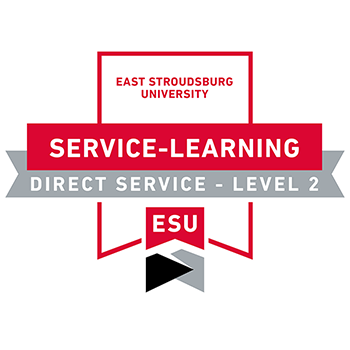 Service-learning is “a course-based, credit-bearing educational experience in which
students (a) participate in an organized service activity that meets identified community
needs and (b) reflect on the service activity in such a way as to gain further understanding
of course content, a broader appreciation of the discipline, and an enhanced sense
of civic responsibility.” Bringle, R.G. & Hatcher J.A. A Service-Learning Curriculum for Faculty.Michigan Journal of Service Learning. Fall 1995, pp 112-122.
Service-learning is “a course-based, credit-bearing educational experience in which
students (a) participate in an organized service activity that meets identified community
needs and (b) reflect on the service activity in such a way as to gain further understanding
of course content, a broader appreciation of the discipline, and an enhanced sense
of civic responsibility.” Bringle, R.G. & Hatcher J.A. A Service-Learning Curriculum for Faculty.Michigan Journal of Service Learning. Fall 1995, pp 112-122.Direct service-learning occurs when students learn about a community issue in class and then provide a service to support people who face that issue. For example, students might visit patients at a hospital, serve meals to those who are food insecure, or walk shelter dogs.
To earn this badge, the student:
- Passed a course at East Stroudsburg University that included a service-learning requirement.
- Provided more than 10 hours of service directly to clients.
- Participated in formal and informal reflection on the impact of the service-learning project.
- Indirect Service Badge – Level 1
-
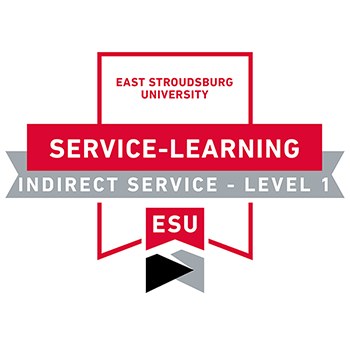 Service-learning is “a course-based, credit-bearing educational experience in which
students (a) participate in an organized service activity that meets identified community
needs and (b) reflect on the service activity in such a way as to gain further understanding
of course content, a broader appreciation of the discipline, and an enhanced sense
of civic responsibility.” Bringle, R.G. & Hatcher J.A. A Service-Learning Curriculum for Faculty. Michigan Journal of Service Learning. Fall 1995, pp 112-122.
Service-learning is “a course-based, credit-bearing educational experience in which
students (a) participate in an organized service activity that meets identified community
needs and (b) reflect on the service activity in such a way as to gain further understanding
of course content, a broader appreciation of the discipline, and an enhanced sense
of civic responsibility.” Bringle, R.G. & Hatcher J.A. A Service-Learning Curriculum for Faculty. Michigan Journal of Service Learning. Fall 1995, pp 112-122.Indirect service-learning occurs when students apply the skills they learned in class to support a community organization. For example, students might analyze survey results, develop a marketing or social media plan, or participate in a clean-up project.
To earn this badge, the student:
- Passed a course at East Stroudsburg University that included a service-learning requirement.
- Provided 1 - 10 hours of service to a community organization.
- Participated in formal and informal reflection on the impact of the service-learning project.
- Indirect Service Badge – Level 2
-
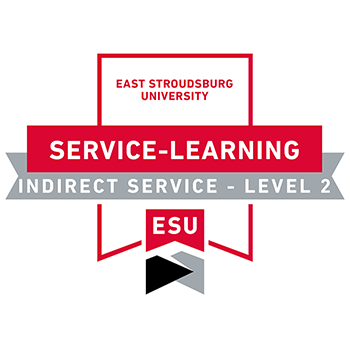
Service-learning is “a course-based, credit-bearing educational experience in which students (a) participate in an organized service activity that meets identified community needs and (b) reflect on the service activity in such a way as to gain further understanding of course content, a broader appreciation of the discipline, and an enhanced sense of civic responsibility.” Bringle, R.G. & Hatcher J.A. A Service-Learning Curriculum for Faculty. Michigan Journal of Service Learning. Fall 1995, pp 112-122.
Indirect service-learning occurs when students apply the skills they learned in class to support a community organization. For example, students might analyze survey results, develop a marketing or social media plan, or participate in a clean-up project.
To earn this badge, the student:
- Passed a course at East Stroudsburg University that included a service-learning requirement.
- Provided more than 10 hours of service to a community organization.
- Participated in formal and informal reflection on the impact of the service-learning project.
- Advocacy Service Badge - Level 1
-
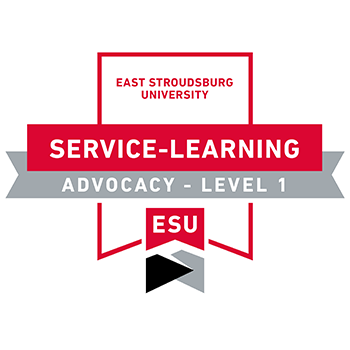 Service-learning is “a course-based, credit-bearing educational experience in which
students (a) participate in an organized service activity that meets identified community
needs and (b) reflect on the service activity in such a way as to gain further understanding
of course content, a broader appreciation of the discipline, and an enhanced sense
of civic responsibility.” Bringle, R.G. & Hatcher J.A. A Service-Learning Curriculum for Faculty. Michigan Journal of Service Learning. Fall 1995, pp 112-122.
Service-learning is “a course-based, credit-bearing educational experience in which
students (a) participate in an organized service activity that meets identified community
needs and (b) reflect on the service activity in such a way as to gain further understanding
of course content, a broader appreciation of the discipline, and an enhanced sense
of civic responsibility.” Bringle, R.G. & Hatcher J.A. A Service-Learning Curriculum for Faculty. Michigan Journal of Service Learning. Fall 1995, pp 112-122.Advocacy service-learning occurs when students learn about an issue in class and strive to educate others or effect policy change concerning the issue. For example, students might write local officials advocating for policy change, hold an event on campus to educate students about the issue, or develop and display art designed to cause people to think about the issue.
To earn this badge, the student:
- Passed a course at East Stroudsburg University that included a service-learning requirement.
- Provided 1 - 10 hours of service by advocating for a social justice cause.
- Participated in formal and informal reflection on the impact of the service-learning project.
- Advocacy Service Badge - Level 2
-
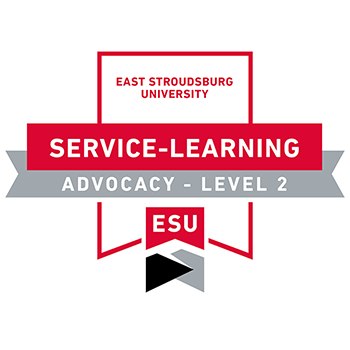 Service-learning is “a course-based, credit-bearing educational experience in which
students (a) participate in an organized service activity that meets identified community
needs and (b) reflect on the service activity in such a way as to gain further understanding
of course content, a broader appreciation of the discipline, and an enhanced sense
of civic responsibility.” Bringle, R.G. & Hatcher J.A. A Service-Learning Curriculum for Faculty. Michigan Journal of Service Learning. Fall 1995, pp 112-122.
Service-learning is “a course-based, credit-bearing educational experience in which
students (a) participate in an organized service activity that meets identified community
needs and (b) reflect on the service activity in such a way as to gain further understanding
of course content, a broader appreciation of the discipline, and an enhanced sense
of civic responsibility.” Bringle, R.G. & Hatcher J.A. A Service-Learning Curriculum for Faculty. Michigan Journal of Service Learning. Fall 1995, pp 112-122.Advocacy service-learning occurs when students learn about an issue in class and strive to educate others or effect policy change concerning the issue. For example, students might write local officials advocating for policy change, hold an event on campus to educate students about the issue, or develop and display art designed to cause people to think about the issue.
To earn this badge, the student:
- Passed a course at East Stroudsburg University that included a service-learning requirement.
- Provided more than 10 hours of service by advocating for a social justice cause.
- Participated in formal and informal reflection on the impact of the service-learning project.
Provost's Colloquia About Service Learning
Contact Us
Contact Information
- Campus Address
- Title of Department Leader
- Co-Coordinator Service Learning
- Name
- Dr. LuAnn Batson-Magnuson
- E:
- batsonmagn@esu.edu
- Phone:
- (570) 422-3311



